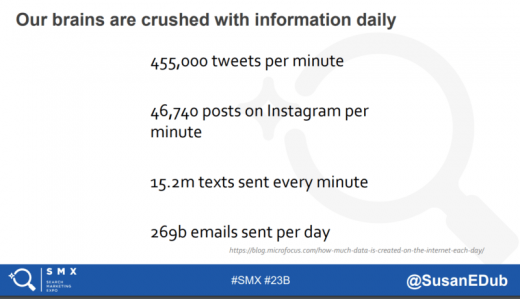SMX Advanced 2018 Session Recap: Storytelling with Social Ads that Sell
Contributor Joe Martinez recaps a session of rock-star paid social media marketers sharing how you can use social media to engage, entertain and motivate readers through the sales funnel.

SMX Advanced attendees were treated to a rock-star lineup of paid social media marketers. Our presenters spoke to the crowd about how we should be using social media to engage users, move them down the funnel and give them the message they want to hear to increase brand interest.
Here’s a recap from the three speakers on the Storytelling With Social Ads That Sell session panel.
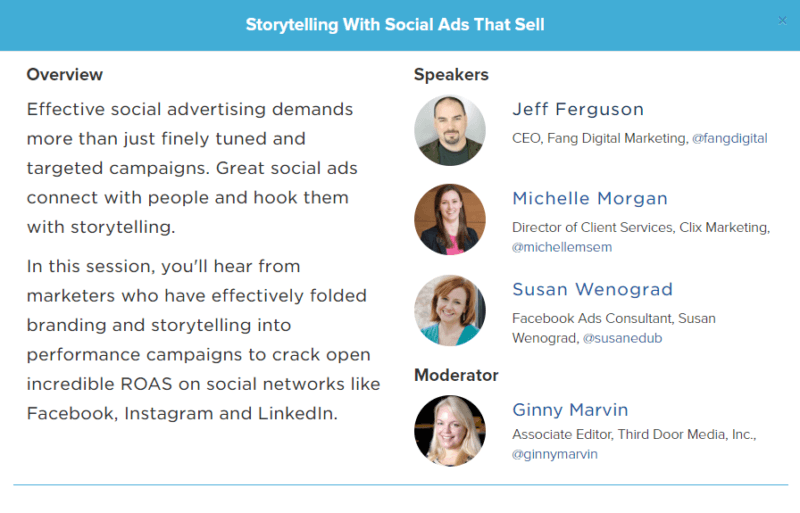
Jeff Ferguson
Jeff Ferguson was first up.
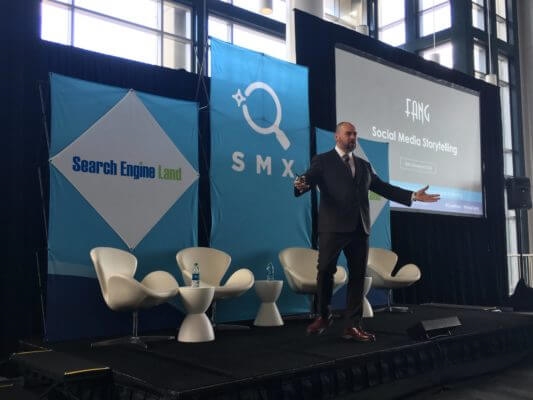
To set up the presentation, he went over a great analogy of creating cocktails. The difference between a Manhattan cocktail and a martini is one ingredient. The difference between a martini and a Gibson is one ingredient.
The message here is that sometimes all you have to do is change one little thing to get something new and amazing. The same idea can be applied to marketing. Maybe one little difference in your ad copy or one little way we tell a story can make a big impact on your campaigns.
Typically, we write content, and it sits there. Maybe we’ll promote it on social media, but many people don’t see these stories we spend a lot of time on. Let’s take our client’s information and use it appropriately for each stage of the content marketing funnel. Jeff then went on to show examples of how he utilizes this approach.
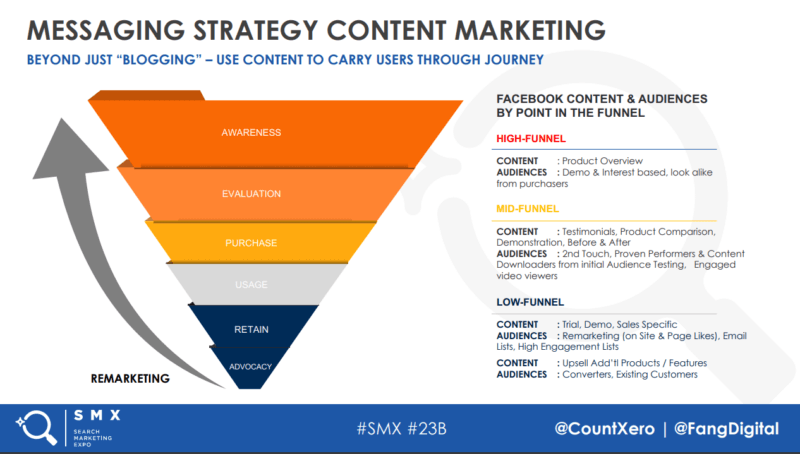
High funnel. For one client who focuses on meal kits for people with serious health concerns, Jeff and his team asked themselves:
- What kind of post is a great introduction?
- What posts can help get users into our funnel?
They found out the meal kit company had a lot of fantastic blog posts which were just sitting on the website with no major traffic. These posts, when finally promoted, led to a lot of user engagement, which was a win. They got the users to notice the brand and introduce them to the funnel.
Mid-funnel. Typically, this is where we see remarketing start to come in. We’re showing ads to users who are already familiar with our brand, even though it may be out of the corner of their eye. Focus the content on:
- Testimonials.
- Product comparisons.
- Demonstrations
- Before-and-after examples.
Consider using audiences of second touch, proven performers, content downloaders and engaged views from the high-funnel approach to keep moving those users along.
Low funnel. This is where we want to be more aggressive in asking for the sale. By the time users are at the bottom of the funnel, we start to really push the offer-driven message. By this point, they’ve seen your brand message at least two or three times, so it’s OK to start asking for the sale.
Going beyond the conversion. It’s typical in marketing to focus on the same thing, so we lose touch with everything. Not only do we want to get the sale, but we want to get those users to come back. We all should care about customer success. Jeff and his team like to look at the entire customer journey and see where they can come in and help out.
The problem with email after the journey is that email open rates are pretty bad, pretty horrible. We’re talking about a 21.8 percent average open rate. If other marketing channels had that type of success rate, we’d all be fired, right?
Customer match is a better option than email to take the user farther down the road. Take the user story farther down the road to keep feeding those users new stories until we hit your end goal.
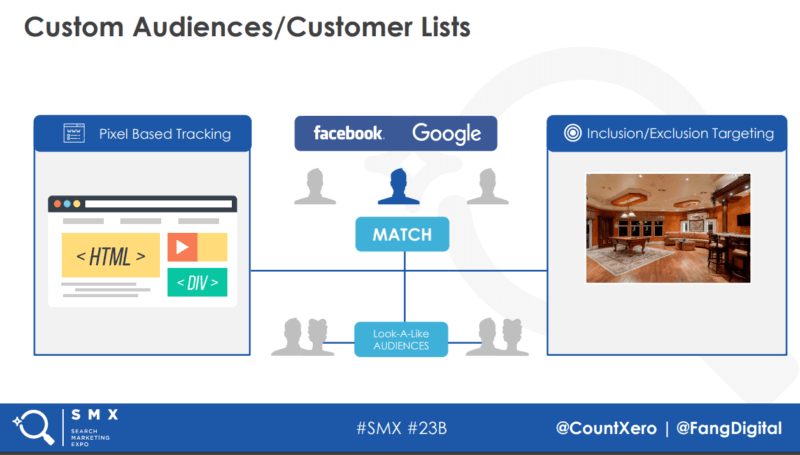
Deciding what to communicate. Keeping in mind the same meal kit client mentioned earlier, audience exposure had a much better result over email. Jeff’s team found out that people who picked their own meals stayed on longer with the program. So they took the updated list of those specific users every week and showed new ads to this customer match audience.
Email rate was 56 percent. Audience exposure for search/social campaigns was 80 percent. The efforts increased meal selections by 50 percent and reduced churn by 20 percent.
Remember, none of these changes are big. Storytelling is about helping a prospect through the entire marketing funnel.
Presentation deck: Social Media Storytelling by Jeff Ferguson
Michelle Morgan
Next up was Michelle Morgan from Clix Marketing, who talked about bringing people back into the funnel.
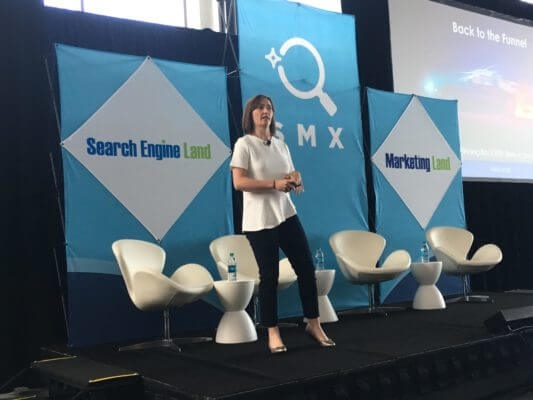
When looking at a basic funnel, we typically see four steps:
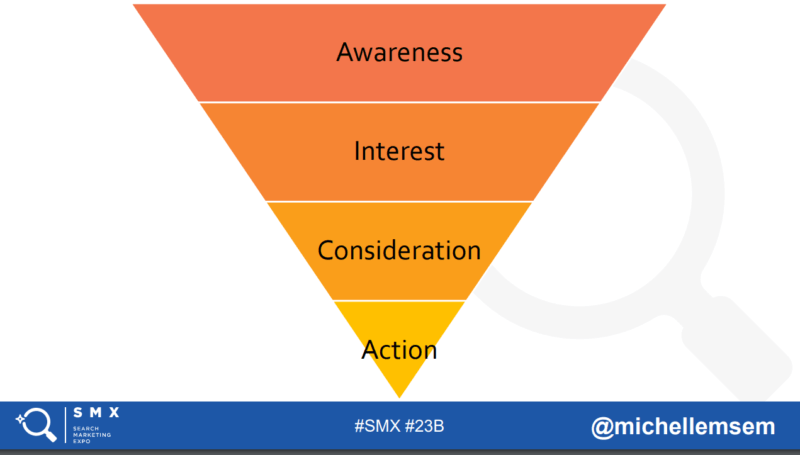
As B2B marketers, our goal should be to turn the stereotypical “funnel” into a shape that makes it easier for users to slide down. How do we do this? Michelle breaks it down.
Make users come back happy. One of the worst things we can do to try and move users along the funnel is crappy remarketing.
For example, let’s say you were trying to get users to download a white paper in your initial campaign. What if they don’t convert off the white paper? Don’t remarket to users who didn’t visit the confirmation page for the past 90 days. Break the audiences down into lower cookie durations. Change your CTA as the time decay flows. Have a firm CTA in the initial 30 days, but soften it after 90 days. Test this same strategy with your offers, too. Try different content (e-book vs. white paper) to see if that makes a difference.
Moving down the funnel. If you’re not doing lead scoring, you’re missing out. Michelle had some great examples of creating a point system with a set threshold to move users down your strategy. Come up with a system where the user maintains a certain “worth” during an agreed upon time duration to know which audience the user actually belongs to, and how they should be marketed.
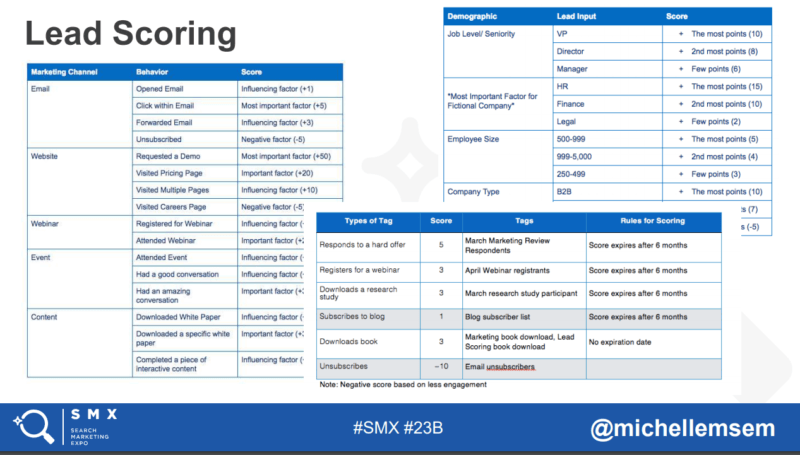
Push users to new content they may not have seen before. Also, move users away from content they have already seen to avoid annoying people with the same message over and over. For users with too low a score, depending on your scoring system, create new lists and re-engage through other marketing channels.
Closing the deal. Win back stalled opportunities with specialized messaging. Sometimes people are deep in the funnel but get stuck for some reasons we can’t easily understand. LinkedIn Sponsored InMail is great. Users only see one ad in their InMail once every 45 days, so you don’t have to worry about bugging users.
Using the LinkedIn ad, offer something they can’t get anywhere else.
Act like a sales rep and work within your customer relationship management (CRM) system. Don’t stop at contacts, look at business targeting. People leave companies all the time, so target the business on LinkedIn, which will be far more accurate than any company targeting on Facebook.
The story is for users. Keep the users’ end goal in mind instead of your own. It’s okay to pick an emotion so your ads don’t seem stuffy. Graphics are great for content, while real-world images are better suited for non-content.
Carousel ads let the person pick the story or let your customers tell the actual story with testimonials.
Presentation deck: Back to the Funnel: Winning Back B2B Users in Social
Susan Wenograd
Last but not least was Susan Wenograd.
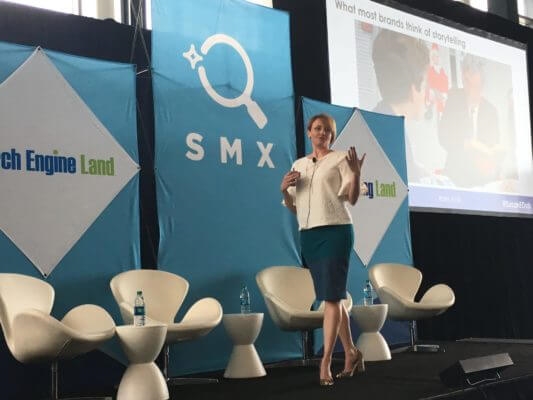
“The Princess Bride” fans rejoiced when Susan mentioned she was going to show why Inigo Montoya is the perfect storyteller, and how he can help your business. Many brands think all storytelling is going to be great. They assume every story they tell is going to surprise and delight their audience. We see many brands tell stories that only talk about themselves and assume users are going to want to buy just based on a brand story.
Ask the user to find out (without asking). Think about what Inigo would do if you asked him a question, and he’d start rambling on about a bunch of facts just like a feature-based ad. Susan had a client who was running a lot of feature-based ads showcasing what the product does, the technology behind it and so on. Very stat-based, right?
Average click-through rate (CTR) for these ads was 1.2 percent. When looking at the assets the client had, Susan noticed users always seemed to be skeptical initially. Once the users found out about how great the product was, they had no problem admitting they were wrong. Susan asked, “Why weren’t we running this in the ad copy?” She ditched all the benefits-and-features ad copy and used a customer-made video echoing her discoveries.
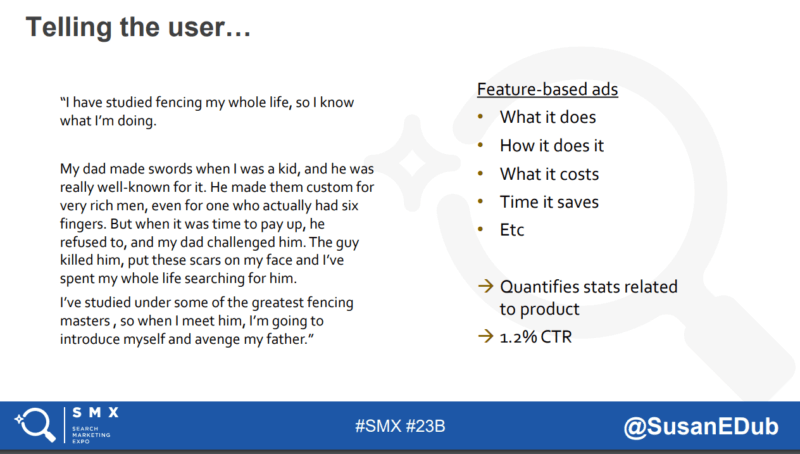
The story-based ad copy quantifies belonging to a community. CTR doubled and helped inform how to improve more than just ads. The new approach also informed how to improve landing page design.
Use what’s memorable and don’t fight it. Do you remember the name of the six-fingered man in “The Princess Bride?” Of course you don’t, you just remember that he’s the six-fingered man. (His name is Count Rogen, in case you really wanted to know).
Brands feel they know what story to tell, but people will be the ones to dictate what story you should be telling.
Consumers control the story, not the brand. Find out what people are searching for and use that in your marketing. Consider creating new landing pages that actually speak to what your users are calling your products or services. Then use those landing page visits as the proper page to create Facebook audiences and then lookalike audiences for a better higher-funnel strategy.
Sometimes, you just can’t run. In a different strategy, Susan had a client who was the face of a new company, while also being well-known from his previous company. Even though the client wanted to separate himself from the old company, he was the six-fingered man. He was the story. They started making “helpful tip” webisodes featuring Susan’s client to leverage his notoriety. Instead of running video views, they tried post engagements after seeing people were naturally engaging due to the story content.
CPMs went from over $5.00 to under $3.90. They focused on the story versus what the company does and saw results improve.
Our brains are crushed with information daily. Ask Inigo Montoya who he is, and he’ll tell you over and over and over:
Hello. I am Inigo Montoya. You killed my father. Prepare to die.
It may be repetitive, but fans of the movies know the quote by heart because they’ve heard it so many times. In marketing, it’s okay for storytelling to repeat the same information more than once. Why? Check this out.
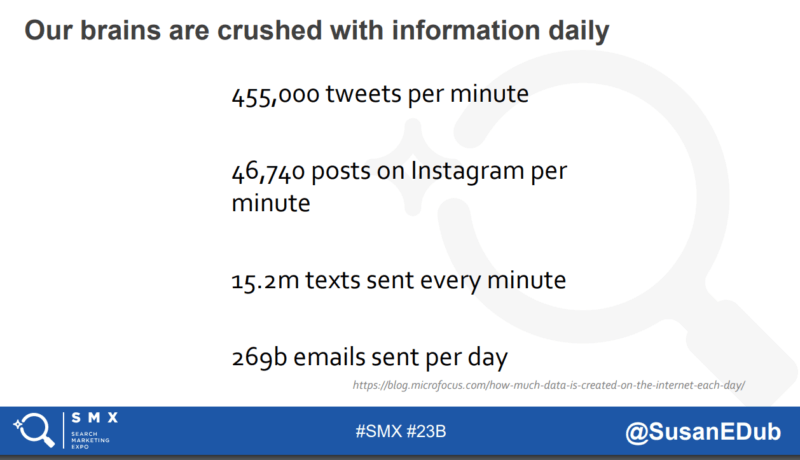
We have to repeat the story, and more importantly, repeat it in multiple places. This type of thinking is going to be extremely important when no one is searching for your brand or products. Susan said it best: “The only way to expand search is to expand the people who will search for your brand.” When you tell your brand story long enough, your language will become your customers’.
Presentation deck: The Inigo Montoya Guide to Storytelling in Paid Social
Opinions expressed in this article are those of the guest author and not necessarily Marketing Land. Staff authors are listed here.
Marketing Land – Internet Marketing News, Strategies & Tips
(8)

